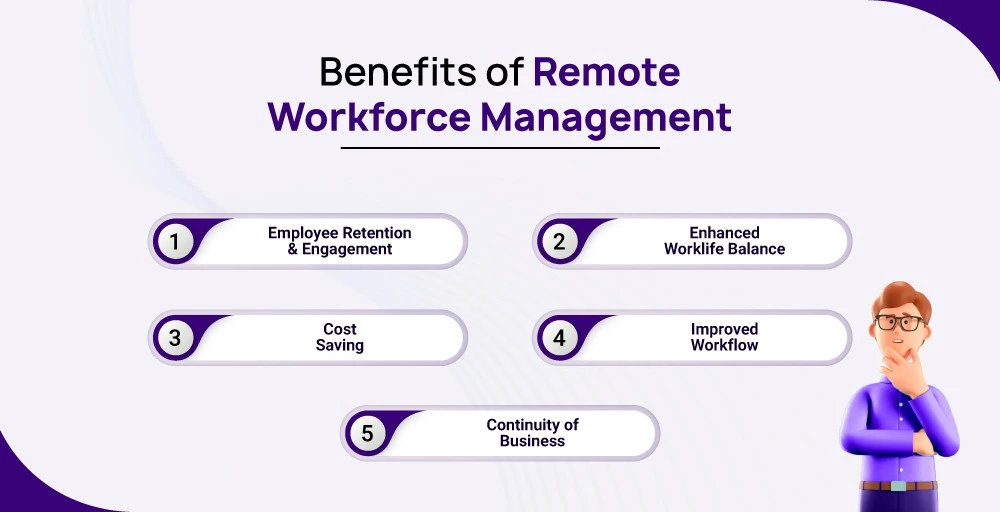The rise of remote work has increased significantly since the 🦠pandemic. As a result, remote workers may feel isolated and communicate less with their colleagues and managers. While flexibility and autonomy might exist in a remote workforce environment, several challenges can exist, including feelings of isolation, 🐌delayed responses, cultural and diversity challenges, 💪team cohesion, and communication barriers.
In the era of virtual technology, traditional communication methods are rarely used. Remote workforce managers have plenty of tasks to maintain each employee’s productivity. We have defined Remote Workforce Management with examples, its benefits, tips, practices, and challenges.
Organizations can address the challenges of a 🏠💻 remote workforce environment, then explore various strategies and mitigate them that can empower employees and drive business growth for the future. One of the most concerning issues in a remote workforce environment is ensuring effective communication and collaboration among the team members. There are plenty of best tips and practices for overcoming this issue. This blog includes a detailed guide on remote workforce management.
Key Highlights
- Remote Workforce Management is very essential for effective collaboration and communication.
- A Remote Workforce Environment can enhance employee morale by creating a work-life balance offering greater flexibility and autonomy.
- Remote work allows remote workers to manage their personal and professional responsibilities effectively, thus leading to increased job satisfaction and overall well-being.
- Promoting Positive organizational norms and values, Conducting timely training and development programs, and prioritizing mental health support of the employees are some of the best tips and practices for remote workforce management.
- KrispCall can be used as the best Remote Workforce Management software to enhance team collaboration and communication amongst remote teams.
What is Remote Workforce Management?
A remote workforce is a process in which employees work together online from a location other than a traditional office. Remote Workforce Management involves employee collaboration and communication through various tools and strategies. It is mainly helpful for businesses that operate outside the office.
Also, Training and Development programs conducted by managers through videoconferencing and virtual presentations can benefit remote employees by helping them learn new skills and ideas.

Tools like Slack, Zoom, Google Meet, etc., can be used for effective remote communication, whereas tools like Asana, Google Workspace, Jira, and Trello can be used for effective remote collaboration. Remote Workforce Management software can maintain employees’ productivity by regularly checking the team’s performance and setting defined goals through audio or video calls.
Also, Activity Engagement Events like Quizzes, Polls, and Surveys can boost employee morale, foster work collaboration, and keep employees engaged and excited. Work-related quizzes are an interactive way to test one’s knowledge.
The quiz winner finally gets the prize, which can motivate everyone to take the quiz later. To ensure no one cheats during quiz time, the primary host or manager can set the time limit or use multiple-choice question formats to make it difficult for the participants.
Polls and Surveys can be an effective way to make important data-driven decisions through Google Forms. Conducting polls during team meetings can help gather each individual’s real-time feedback. Conducting surveys can help gather feedback after the team meeting and implement it properly by tracking trends and addressing employees’ concerns.
An example of a Remote Workforce Management System can be like this:
“Shawn is the CEO of an IT company. The company suddenly moved to a remote workforce due to the maintenance of the office building structure. Now, He needs to apply for or practice the remote workforce method to ensure his and the team’s work isn’t disturbed. Then, He makes a plan to manage the workforce by giving all the employees access to project management tools like Trello, Jira, or Infinity. Then, Daily Stand-up meetings are scheduled via Zoom or Google Meet to ensure the team is aligned.”
What are the Benefits of Remote Workforce Management?
Managing a remote workforce is not a small thing. The managers can hire anyone from all over the world and make a team. With the use of modern technologies, one can efficiently work remotely. The benefits of remote workforce management are as follows:

1. Employee Retention and Satisfaction
One significant benefit of remote workforce management is employee retention. The remote workforce can help boost an employee’s morale and satisfy their needs, leading to higher employee retention with less turnover rate.
Using Slack for daily communication and performance and project management tools for collaboration can satisfy employees’ work styles, helping them retain and be satisfied with their jobs.
2. Enhanced Worklife Balance
Managing a remote workforce can help improve work-life balance for employees and employers. Time-tracking software with break options can help improve and balance the work-life structure. During the break, one can start practicing hobbies to reduce stress and boost overall well-being.
A remote workforce can help employees, employers, and managers create a balanced daily work routine, allow them to spend more time with their family members, and provide a stronger support system to motivate them in their task schedules.
3. Cost Saving
Another main benefit of remote workforce management is cost savings. With a remote workforce, Companies can save on office expenses and facilities by not having to pay office rent, basic utilities, and maintenance costs. Overall, it helps to reduce overhead costs.
A remote workforce environment can also lower operational costs. For companies offering competitive pricing for their products or services, this can result in a higher profit margin and a competitive advantage.
4. Improved Workflow
Employees can work more focused and concentrated in a remote workforce environment, allowing faster task completion and high-quality work. Efficient communication and collaboration with virtual meetings platform can also improve the employees’ workflow with quick, effective, and fruitful discussions.
Feedback sessions at the end of the discussion can lead to a proper decision-making process. With performance-tracking software, managers can monitor each employee’s progress and track the status of their project to enhance accountability.
5. Continuity of Business
A remote workforce ensures that business operations are uninterrupted if natural disasters or pandemics occur. This can help maintain business productivity. A remote workforce enables all company employees to maintain and assist customers or clients through remote selling without interruption.
Cloud-based services are the most important part of a remote workforce environment. They help ensure the business runs smoothly with effective communication and collaboration through various tools like Slack, Google Meet, Zoom, and, most importantly, KrispCall.
What are the Challenges of Remote Workforce Management?
Though Remote Workforce Management has many benefits, employees, and managers may face some challenges. Organizations or companies must address these challenges to ensure an effective operation and employee satisfaction.
Some of the major challenges of remote workforce management are as follows:
1. Physical and Mental Health Challenges
Prolonged sitting can cause back or neck pain in remote workers. Since they don’t move around in a remote workforce environment, this can increase the risk of obesity and cardiovascular disease. Continuous screen time may also cause eye strain or headaches.
Not only physical challenges, but remote workers can face mental health challenges as well, and a lack of interaction with other colleagues can lead to isolation that can affect the well-being of a person. It can sometimes lead to anxiety, stress, or even depression.
2. Maintaining Organizational Culture and Rules
Another major challenge of remote workforce management is maintaining the organization’s culture and rules. Fostering the organization’s culture while working remotely can be challenging, and managers may find it difficult to implement the same organizational rules as in a traditional office.
Remote workers can have limited opportunities to lead a team and become role models for other team members due to a lack of interaction between one another. Also, new hires can lack socialization during onboarding, making it difficult to follow company values and norms.
3. Network Issues & Challenges
Sometimes, a power outage might affect team meetings and presentations and waste the time of other remote workers. Also, network connectivity issues might lead to disruption or information delay.
Network issues can decrease the productivity of remote workers. Also, tech support teams can find it difficult to troubleshoot network challenges due to physical unavailability. Resolving hardware and faulty routers can take longer for employees.
4. Challenges in Optimizing Efficiency and Output
Managers can have accountability issues when assigning remote workers tasks. It can be challenging for them to monitor their performance, performance, and productivity without the physical insight.
Remote workers can also have challenges optimizing efficiency and output due to distractions from family members and pets, affecting overall productivity. Protection against cyber threats can also be a challenge in a remote workforce.
5. Communication Barriers
Lastly, communication barriers are another major challenge in remote workforce management. As a remote workforce eliminates face-to-face interactions or discussions, it can cause miscommunication or a slower decision-making process.
Also, there might be language barriers while communicating with remote teams from all over the world. It can be difficult for translators to translate the language. Different time zones can result in delays in communication, impacting the project’s efficiency and timeline.
Best Tips & Practices to Manage a Remote Team
Managing a remote team requires various communication strategies, tips, and practices to make sure the team involves proper collaboration, productivity, innovation, etc.
Some of the remote workforce best practices and tips for managing a remote team are as follows:
1. Mutual Support Among Team Members
One of the best tips or practices for managing a remote team is to have mutual support among the team members. This is crucial for building a cohesive remote work environment and creating a platform where team members feel comfortable sharing their opinions, ideas, and concerns without fear of judgment.
Utilizing multiple channels or communication platforms like Slack for connection, conversation, and regular video meetings using Zoom or Google Meet for face-to-face interaction can help remote workers have mutual support among each other.
2. Foster Proper Team Collaboration and Cohesion
Another main practice for managing a remote team is fostering proper collaboration and using tools like Asana and Trello to manage a team’s collaboration tasks. This can streamline the main task workflow and give an overview of the team assignment procedure.
The team should clearly define the roles and responsibilities to avoid overlap or confusion. Also, Giving continuous feedback for improving and staying aligned with the team goals can help foster proper team collaboration and cohesion.
3. Prioritize Mental Health Support of an Employee
Another main tip and practice for managing a remote team is prioritizing the mental health support of the employees. Reminding the team to take timely breaks and setting clear boundaries between work and personal time can be one major way to promote work-life balance.
Providing mental health training for addressing issues and offering access to mental health professionals through Employee Assistance Programs is a better way to create a productive and supportive remote work environment.
Ensuring no employee is overloaded with tasks and that every employee has proper access to necessary tools and technologies is also a better way to ensure a productive and supportive remote work environment.
4. Promote Positive Organizational Culture and Norms
Promoting positive organizational culture and norms is one of the best practices and tips for managing a remote team. One should clearly define the organization’s core values and ensure they resonate with the team’s goals and culture.
Ensuring the new employees or hires clearly understand the organization’s culture and norms through onboarding is another way to promote a positive remote workforce environment.
5. Training and Development Programs
Lastly, conducting training and development programs is another best practice and tip for managing a remote team. One way to do this is to conduct Skill Development programs through online workshops and webinars, including leadership, time management, and other soft skills.
Utilizing and Leveraging online e-learning platforms like Udemy, Coursera, and similar courses can help remote workers gain knowledge on various important topics. Recorded and Live sessions can be essential training or development programs for managing a remote workforce.
Conclusion
Remote Workforce Management has been essential as it offers cost savings, enhanced employee morale, and improved work-life balance. Effective remote workforce management involves many strategies and practices. The above-mentioned practices and tips can help create a productive and supportive remote work environment.
It might include several benefits, including enhanced balanced work-life, cost savings, and improved workflow. However, overcoming challenges like network issues, physical and mental health problems, and communication barriers requires a lot of strategies and practices with excellent communication and trust building.
KrispCall is the best solution for remote workers to work with more productivity. It’s useful mainly for remote call center agents to communicate with customers. Also, KrispCall’s integration with various CRM tools can optimize the productivity of remote workers and streamline their working operations. You can book a free Demo to check whether your remote workforce business meets the requirements.
FAQs
What tools are important for managing a remote workforce?
Time Tracking, Project Management, and Communication or Collaboration tools are important for managing a remote workforce. It includes Slack, Trello, Google Meet, etc.
Can there be conflicts in a remote workforce environment?
Of course, conflicts can occur in a remote workforce environment due to uneven workload distribution among team members, and delayed responses due to time zone differences can frustrate remote workers.
How can I ensure effective communication in a remote workforce?
Effective communication in a remote workforce environment can be ensured by utilizing the right communication tools, scheduling regular check-ins and updates, enhancing written communication skills, fostering team collaboration, promoting mental health and well-being, and encouraging social interaction.





